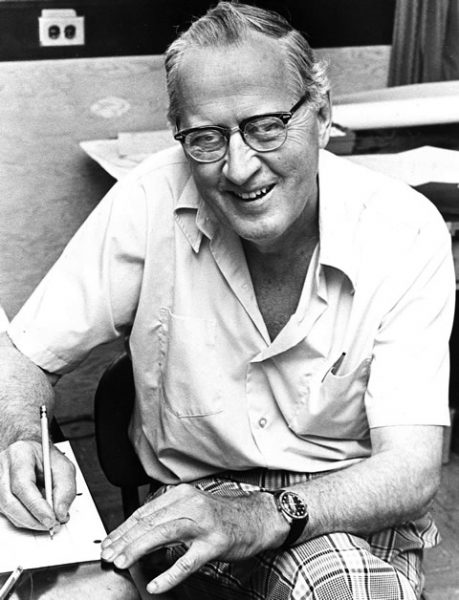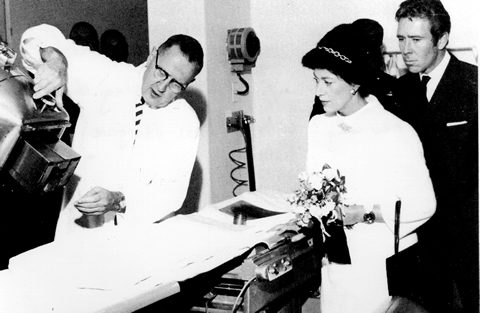
Harold Johns has been called one of the most influential medical physicists in Canadian history. The inventor of the “cobalt bomb,” a nuclear radiation device that revolutionized the treatment of cervical, bladder and prostate cancers, Dr. Johns was responsible for saving the lives of millions of people around the world through his pioneering cobalt-60 therapy.
Harold Elford Johns was born in Chengtu, Western China – then a city of a million people near the eastern Tibetan mountains – on July 4, 1915. In a letter home to Canada, his missionary father, Alfred described eight-year-old Harold as precocious and “the most active” of his and wife Myrtle’s five children. Following his graduation from U of T with an MA and, in 1939, with a PhD in physics, Johns was awarded a scholarship to the University of Cambridge – but his plans were waylaid by the outbreak of the Second World War, and he remained in Canada, teaching math, radar and radio navigation to air force pilots.
After the war, Johns joined the physics department of the University of Saskatchewan and started the medical physics group at the new Saskatchewan Cancer Commission. In the years during and following the Second World War, Canada moved to the forefront of nuclear energy research through groundbreaking work at the National Research Council’s facilities in Montreal and in Chalk River, Ontario. At that time, Chalk River was the only reactor in the world capable of producing significant quantities of radioactive cobalt – otherwise known as cobalt-60, which is about 100 times stronger than radium. In the late 1940s, Johns teamed up with other Canadian researchers to create a machine capable of beaming high-energy radiation at patients to attack cancerous tumours located deep within the body.
Two prototypes of John’s cobalt-60 therapy units were built — one in Saskatchewan and a second in Ontario. The first patients were treated in the fall of 1951, at the University of Saskatchewan and at the Victoria Hospital in London, Ontario. Dr. Johns’ first patient was completely cured of her cancer and lived into her 90s. News of Johns’ revolutionary new treatment appeared in magazines and newspapers across Canada and around the world. (It was even reported, most likely incorrectly, that Eva Perón, the first lady of Argentina, had flown to Canada to receive treatment for advanced cervical cancer.) In a ceremony celebrating the installation of Toronto’s new cobalt-60 unit, in November 1953, health minister Paul Martin Sr. (father of Prime Minister Paul Martin, BA 1961 St. Michael’s, JD 1964) expressed his enthusiasm for the new device. “While cancer is still the second leading cause of death in Canada,” Martin said, “there is greater hope for the cancer sufferer than ever before.”

Dubbed the “cobalt bomb” by Maclean’s, cobalt-60 therapy was akin to dropping heavy explosives on certain types of cancer, and it proved highly effective against cervical, bladder and prostate cancers. Johns’ therapy became the gold standard for radiation therapy and thousands of units were installed around the world, helping countless patients. In the 1940s, one in five Canadian patients survived for five years after getting cancer. Today, as a result of improved treatments, including cobalt-60, Canadians’ five-year survival rate has tripled to more than three in five
Cobalt-60 was to be Johns’ most newsworthy achievement. However, in the years and decades that followed, he became almost as well known for his leadership in the field of medical biophysics and for his dedication to teaching and mentoring students. “Johns was a team player,” recalled his son-in-law Dr. Clive L. Greenstock, “and believed that if a thing was worth doing, it was worth doing to the best of one’s ability. He was a great teacher and a hard worker who brought out the best in those around him.” In 1953, Johns published The Physics of Radiology, considered the bible of medical physics. In 1956, he moved to Toronto to head up the physics division at the Ontario Cancer Institute at Princess Margaret Hospital and two years later, he created U of T’s graduate department of medical biophysics.
Over the course of his long career, Johns supervised dozens of graduate students – today, most of the medical physicists in Canada can trace their roots back to him. Among his many awards, in 1978, Johns was appointed to the Order of Canada, in recognition of his lifetime of devotion to cancer research and improvements in diagnosis and treatment. Suffering from Parkinson’s disease, he retired in 1980 and died on August 23, 1998, at the age of 83, leaving his wife of 58 years Sybil, three daughters, several grandchildren and myriad friends and colleagues.
By the end of last century it is estimated that cobalt-60 cancer therapy had helped more than 70 million people around the world. Sylvia Fedoruk, who worked with Johns on the cobalt-60 project and was at the time Canada’s only woman medical physicist, offered perhaps the best description of Johns’ legacy. “The ‘bomb’” she said in a magazine article, “was, in practice, a plowshare rather than a sword.”
Recent Posts
People Worry That AI Will Replace Workers. But It Could Make Some More Productive
These scholars say artificial intelligence could help reduce income inequality
A Sentinel for Global Health
AI is promising a better – and faster – way to monitor the world for emerging medical threats
The Age of Deception
AI is generating a disinformation arms race. The window to stop it may be closing





3 Responses to “ This “Bomber” Actually Saved Countless Lives ”
Thank you for this excellent summary. I was a graduate student in the Johns lab in the mid-1970s, and he was a driving force for all members of the physics department at the Ontario Cancer Institute at Princess Margaret Hospital.
I have one small correction to the article. The second commercial model of the Cobalt unit (Eldorado A) was designed by Donald Green and Roy Errington of the Eldorado Mining & Refining company (later Atomic Energy of Canada). It was shipped to Victoria Hospital in London, Ontario, where Dr. Ivan Smith administered the world's first Cobalt-60 treatment to a cancer patient on Oct 27, 1951. This was to the dismay of the hard-working SaskatoonpPhysics team led by Johns. They delivered their first treatment on Nov. 11 -- just a few weeks "too late" to be the world premiere.
I enjoyed this article on Dr. Johns. I knew his mother Myrtle in Hamilton, Ontario, in the 1970s. She was the family historian and was very proud of the achievements of her children. She and I were distant cousins, both being descendants of the Whitlocks of Langtree, Devon. She was also an amazing lady.
According to my mother and my grandfather, my grandmother was the patient at Victoria Hospital in London, Ontario, to receive the first Cobalt-60 treatment on Oct 27, 1951.